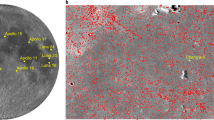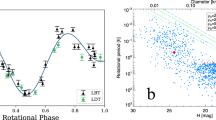Abstract
ONE of the most important tasks in selenology is to establish the relative ages of different parts of the lunar crust. It may be argued that, during the lifetime of a crater, its floor would be darkened at a uniform rate by the destructive effects of ultra-violet light on the rock crystals. The empirical relationship :  may be fitted to the albedo (ρ) measurements of Markov and Fedorets1, where Δ is the diameter of a crater in kilometres.
may be fitted to the albedo (ρ) measurements of Markov and Fedorets1, where Δ is the diameter of a crater in kilometres.
This is a preview of subscription content, access via your institution
Access options
Subscribe to this journal
Receive 51 print issues and online access
$199.00 per year
only $3.90 per issue
Buy this article
- Purchase on Springer Link
- Instant access to full article PDF
Prices may be subject to local taxes which are calculated during checkout
Similar content being viewed by others
References
Markov, A. V. (ed.), The Moon, 170 (Univ. of Chicago Press, 1962).
Author information
Authors and Affiliations
Rights and permissions
About this article
Cite this article
FIELDER, G. Determination of Relative Ages of Lunar Craters by Albedo and Polarization Measurements. Nature 197, 69–70 (1963). https://doi.org/10.1038/197069a0
Issue Date:
DOI: https://doi.org/10.1038/197069a0
Comments
By submitting a comment you agree to abide by our Terms and Community Guidelines. If you find something abusive or that does not comply with our terms or guidelines please flag it as inappropriate.



